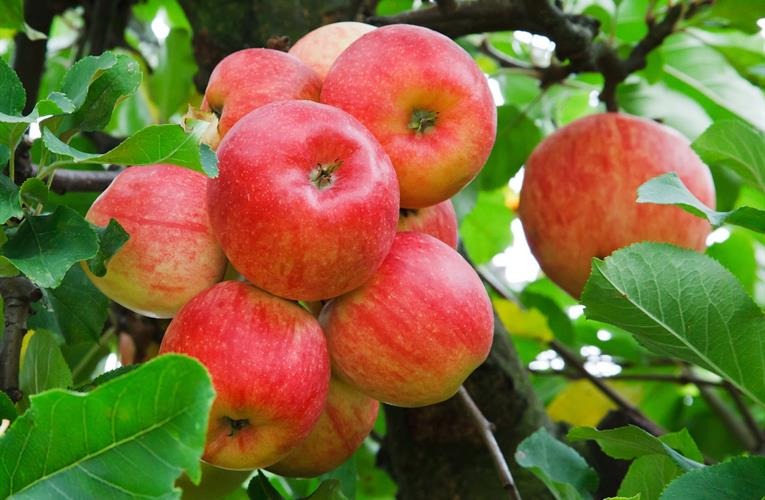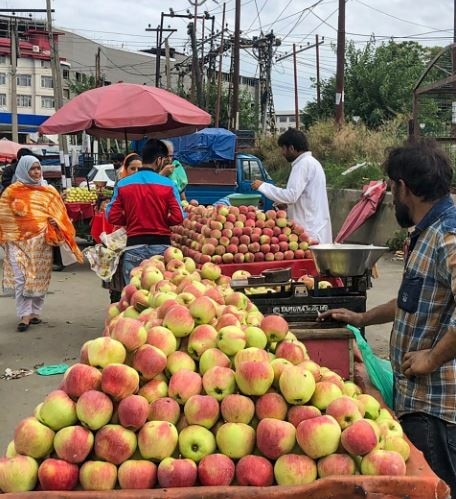The Bitter Taste of Climate Change in Kashmir’s Apple Paradise
By: Javid Amin | Srinagar | 04 July 2025
In the lush green valleys of Kashmir, where apple orchards once flourished under perfect climatic rhythms, a silent crisis is ripening—literally and figuratively. This year, an unprecedented heatwave combined with a prolonged rainfall deficit has begun to disrupt the core of Kashmir’s ₹8,000 crore apple economy, threatening the livelihoods of over 3.5 million people who depend on the fruit in one way or another.
As temperatures soar above 30°C and rain clouds remain absent from the sky, apple growers across Shopian, Pulwama, Sopore, Anantnag, and Baramulla are witnessing the unthinkable: early-ripening fruits with blotchy skins, low weight, and limited shelf life. The high-altitude charm of Kashmiri apples, known globally for their firm texture, deep red hues, and long storage potential, is quickly turning into a tale of climate-induced tragedy.
What’s Happening in Kashmir’s Orchards Right Now?
01. Heatwaves Leading to Premature Ripening
This season, heatwaves arrived early and stayed longer than expected, with some districts recording temperatures as high as 34–36°C, a level that spells disaster for apple development.
-
Apples ripen too fast, leading to fruits that are smaller, less juicy, and visually unappealing.
-
Pigmentation is poor, especially in premium varieties like Red Delicious and Ambri.
-
Premature softness means the fruits can’t survive long transport or storage periods, affecting both local markets and export prospects.
“My apples look ripe, but they’re not ready inside. This fast ripening destroys quality. We can’t sell these in Delhi or Mumbai,” laments Ghulam Nabi, an orchardist from Sopore.
02. Rainfall Deficit Drying Out Orchards
Equally concerning is the lack of rainfall during the critical growth months of June to August. Traditionally, this is the period when apple trees need plenty of water to swell their fruits and develop flavor.
-
October 2024 saw an 87% rainfall deficit—with some areas receiving just 4 mm against the average 31 mm.
-
Spring rainfall was also irregular, leading to poor flowering and fruit setting.
-
High-density plantations, which produce more fruit per acre, are struggling without consistent irrigation, even in places with drip systems.
“Earlier, the glaciers used to feed our canals even if rains failed. Now everything’s dry—even the Lidder Nallah,” says Bilal Ahmad, an orchard supervisor from Anantnag.
Sunscald, Smudging & Disease—The Unseen Fruit Damage
01. The Scorch Marks of Climate Change
One of the most visible and devastating effects of the heat is sunscald, a condition where apples develop burnt patches due to prolonged exposure to direct sunlight.
-
These blemishes lower market value as A-grade apples need to be visually perfect.
-
Even if the taste remains intact, buyers—especially in export markets—reject sun-damaged fruit.
“An A-grade apple becomes C-grade just because of one spot. That’s the reality of market standards,” explains Bashir Khan, a fruit grader in Sopore’s wholesale mandi.
02. Humidity-Induced Diseases Are Spreading
The high humidity mixed with intense heat has created a perfect storm for fungal infections, including:
-
Sooty blotch and flyspeck, which make apples look dirty and affect photosynthesis.
-
Apple scab, which attacks both leaves and fruit.
-
Powdery mildew, especially in young orchards, affecting next year’s yield potential.
The Economic Impact—From Orchard to Market
01. Declining Yields, Declining Incomes
With rising temperatures and drying fields, yields are dropping, especially in the A-grade category that fetches the highest price.
-
High-density apple farmers are witnessing 15–20% drop in top-quality yield.
-
Traditional orchards are seeing up to 30–40% decline in overall production.
For farmers who took loans to upgrade to modern irrigation and pest-control systems, this is a financial blow they cannot afford.
02. Transport & Storage Challenges
Fruits affected by heat have:
-
Shorter shelf life: making them unsuitable for storage or export.
-
More bruising during packaging and transport due to weaker skin.
-
Rejections from mandis or low pricing at auctions.
A crate that would normally sell for ₹1,200–₹1,500 is now fetching just ₹600–₹800, putting enormous pressure on rural economies dependent on apple revenues.
The Climate Trends Fueling the Crisis
01. Kashmir’s Fragile Microclimate Is Shifting
Experts point to a larger pattern of climate disruption:
-
Average summer temperatures have increased by 2–3°C over the past decade.
-
Snowfall has reduced by 35%, affecting snow-fed irrigation in spring and early summer.
-
Glacial retreat is accelerating, especially in the Pir Panjal and Harmukh ranges.
These shifts have shortened the apple growth window while increasing heat exposure hours, a dangerous combination for quality farming.
“The ideal temperature for apple pigmentation is 22–28°C. Beyond 30°C, the fruit starts losing color and firmness,” says Dr. Mudasir Shah, a horticulturist with SKUAST-K.
02. Deficit Rains—A New Normal?
Rainfall during October 2024 was 87% below normal, but this is not a one-time anomaly.
-
In the last five years, Kashmir has recorded three drought years, severely impacting agriculture and horticulture both.
-
Traditional spring-fed irrigation is disappearing due to urbanization, deforestation, and glacier loss.
What Are the Possible Solutions?
01. High-Density Apple Varieties Are Part of the Answer
Government and private players are now pushing for:
-
High-density varieties like Gala, Super Chief, and Scarlet Spur, which mature faster, require less water, and are more sun-tolerant.
-
These varieties are yielding 3–4x more fruit per acre, helping offset losses in traditional systems.
However, initial investments are high, and training is required for proper canopy management and irrigation.
02. Water-Smart Practices and Infrastructure
Efforts are being made to:
-
Install drip and micro-sprinkler systems that deliver precise water doses.
-
Encourage rainwater harvesting, though success remains limited in sloped terrains.
-
Subsidize shade nets that protect fruit from direct sunlight and wind damage.
03. Crop Diversification & Seasonal Flexibility
To reduce dependency on apples alone:
-
Farmers are being encouraged to cultivate pulses, mushrooms, and vegetables in fallow orchard spaces.
-
Intercropping methods are gaining traction in Budgam and Pulwama districts.
04. Crop Insurance Gaining Popularity
With frequent crop failures and quality downgrades:
-
Weather-based crop insurance schemes are gaining attention, especially among large-scale growers.
-
However, lack of awareness and complex paperwork remains a barrier in rural areas.
Voices from the Orchard—Farmers, Experts, and Traders Speak
“We’re Not Just Losing Apples—We’re Losing Hope”
“In my 25 years of farming, I’ve never seen July this dry. Not a single rainfall, and the trees are wilting. I fear we won’t make it to harvest,” says Shabir Lone, an orchardist from Kupwara.
“Market Value Means Appearance—Not Effort”
“A small scar or smudge can cost ₹200 per crate. Buyers don’t care about the weather—they want shiny fruit,” explains Nazir Ahmad, a fruit trader in Parimpora.
“Science Can Help, But Policy Must Lead”
“We need better extension services, easy subsidies, and real-time weather alerts. The farmer must not feel abandoned,” adds Prof. Mehraj-ud-Din of SKUAST-K.
Bottom-Line: A Climate Wake-Up Call for Kashmir’s Apple Industry
What’s unfolding in Kashmir’s apple belt is not just a seasonal hiccup or isolated event—it is a systemic warning. As climate variability becomes the new normal, horticulture cannot rely on age-old practices alone. The future lies in a hybrid approach that balances traditional knowledge with climate-smart technology and policy-driven support.
To protect the heart of Kashmir’s rural economy, urgent action is needed—from investment in irrigation to promotion of resilient varieties, from weather insurance adoption to grassroots climate education. And perhaps most importantly, farmers must no longer be left alone to face nature’s wrath.



